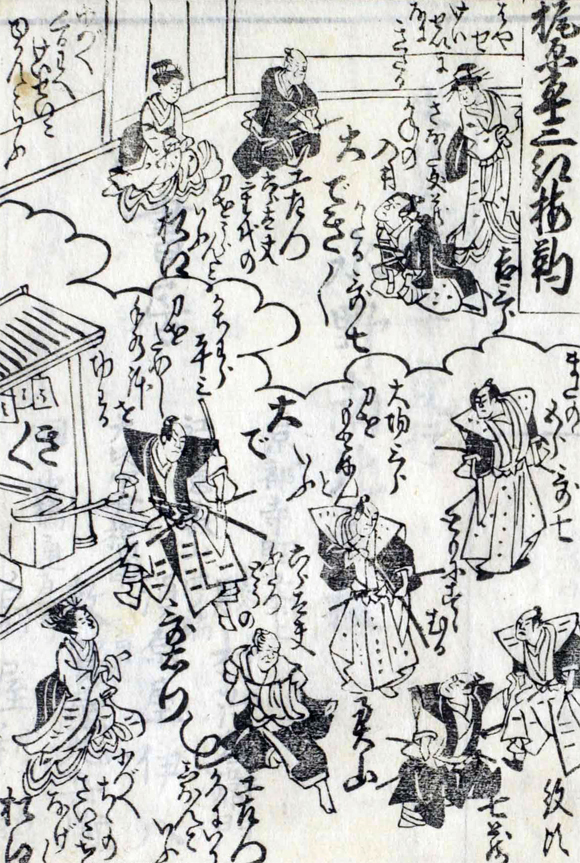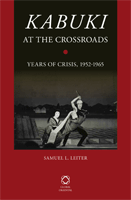| MIURA NO ďSUKE KďBAI TAZUNA |
| Play titles | Miura no ďsuke K˘bai Tazuna [1] Kajiwara Heiz˘ K˘bai Tazuna Kajiwara Heiz˘ Kitai no Ishikiri Kajiwara Heiz˘ Homare no Ishikiri The Stone-Cutting Feat of Kajiwara Heiz˘ Kajiwara Heiz˘ Tameshi no Wazamono Na-mo Tachibana Homare no Ishikiri |
|||
| Common title | Ishikiri Kajiwara |
|||
| Authors | Hasegawa Senshi Matsuda Bunk˘d˘ Kanazawa Ryűgoku I (1821/1822) |
|||
| History |
The drama "Miura no ďsuke K˘bai Tazuna" was originally written for the puppet theater (Bunraku) and staged for the first time in the 2nd lunar month of 1730 in ďsaka at the Takemotoza. It was adapted for Kabuki a fews months later and staged for the first time in the 8th lunar month of 1730 at the Kado no Shibai. It was staged for the first time in Edo in the 6th lunar month of 1795 at the Kiriza [casting]. Then, it went into oblivion for more than 2 decades. It was revived by the Kamigata star Nakamura Utaemon III, who revised the script for the third act under his pen name of Kanazawa Ryűgoku I. It became an independent drama, staged in the 3rd lunar month of 1821 at the Kado no Shibai under the title "Kajiwara Heiz˘ K˘bai Tazuna" [casting] and in the 11th lunar month of 1822 at the Kitagawa no Shibai under the title "Kajiwara Heiz˘ Kidai no Ishikiri" [casting]. The title "Kajiwara Heiz˘ Homare no Ishikiri" was used for the first time in June 1892, in Nagoya at the Suehiroza [2]. From the end of the 19th century, 3 stars contributed to popularize and magnify the role of Kajiwara Heiz˘ Kagetoki: Nakamura Ganjir˘ I (first time in November 1896 at the Naniwaza), Nakamura Kichiemon I (first time in November 1905 at the Kabukiza) and Ichimura Uzaemon XV (first time in February 1919 at the Kabukiza). |
|||
| Structure |
The drama "Miura no ďsuke K˘bai Tazuna" was made up of 5 acts and its most famous scene, which was the final one in the third act, became an independent drama staged on different titles, the most famous one being "Kajiwara Heiz˘ Homare no Ishikiri". This scene is commonly called "Ishikiri Kajiwara" (literally 'stone-cutting Kajiwara'). The role of Kajiwara is one of the finest examples of sabakiyaku, belonging to the Kak˘shű collection of dramas set by the star Ichimura Uzaemon XV |
|||
| Key words |
Aogaishi Ch˘zubachi Genpei Kassen Genpei-kassenmono Genji Gidayű Ky˘gen Giri/Ninj˘ Hatakeyama Shigetada Heian Jidai Heike Ishibashiyama no Tatakai Izu Jidaimono Kajiwara Kagetoki Kak˘shű Katana Kinugasa-j˘ Kon'ya Matano Kagehisa Minamoto Yoritomo Minamoto Yoshitomo Minamoto Yoshitsune Miura ďsuke Miura-shi Monogatari ďba Kagechika Sabakiyaku Shisha Tameshigiri Terakoya Tsurugaoka Hachimangű |
|||
| Summary |
In the earlier scenes, Okatsu, widow of Hacch˘-tsubute no Kiheiji, who died after incurring the wrath of Yoritomo's father, Yoshitomo, comes with her son, Daizabur˘, to Yoritomo's residence in Izu, and pledges her loyalty. He fled there after being defeated at Ishibashiyama, and is trying to raise an army. The clan gathers at Kinugasa Castle to celebrate the 106 years lived by Miura ďsuke. Only his grandson-in-law, Hatakeyama Shigetada, refuses to participate, because he belongs to the Heike. A messenger arrives from Yoritomo, and ďsuke hastens to Yoritomo. ďsuke's daughter, Otoshi, worried about her grandson, Sanada Yoichi, travels (in a michiyuki) to Ishibashiyama. In her dream, Sanada Bunz˘ informs her of Yoichi's death. The greedy kon'ya Matakurobŕ marries Okatsu. A message from Yoritomo is mistaken for an adulterous letter to Okatsu. Believing his love rival to be the village terakoya schoolmaster Sadaemon (actually Sanada Bunz˘), Matakurobŕ ends up being killed by the latter. The dying Matakurobŕ then confesses that he is Kiheiji's father and hands over 700 ry˘ intended for military use to be given to Daizabur˘. Bunz˘, needing to provide 300 ry˘ to Yoritomo for his campaign, sells his wife, Kozue, daughter of the old inlay craftsman (aogaishi) Rokur˘dayű into prostitution. This is the background for the action still staged. It takes place in springtime, during cherry blossom time, before the Tsurugaoka Hachiman Shrine (or Hoshiai Temple [3]) in Kamakura after ďba Sabur˘ Kagechika defeat of Yoritomo. ďba and others are celebrating the victory at Ishibashiyama when they are joined by Kajiwara. Kajiwara and ďba share in the festivities, despite an undercurrent of distrust between them. Rokur˘dayű appears with Kozue to sell a precious sword belonging to Bunz˘ in order to raise war funds. The sword has been offered to ďba for 300 ry˘, but the Heike general has asked for time to consider so expensive a purchase. ďba asks the knowledgeable Kajiwara for his opinion of the sword, which Rokur˘dayű has brought with him. Kajiwara, after careful inspection, notes that the sword is outstanding, although the would-be purchaser declares a blade can only be tested by seeing if it can cut through two human bodies with one blow. A command is given for two criminals to be hauled out so that the weapon can be used on them. When only one is available, the hesitant ďba begins to back out from completing the deal. After Rokur˘dayű sends Kozue away to do something for him, he offers to substitute himself for the second body, provided Kozue be paid for the sword. The old man listens to ďba's warning about his foolhardiness, but insists that his financial needs require even his death. Kajiwara, learning of the arrangement, is unwilling to participate, despite Rokur˘dayű's pleas. Kikubei, a messenger, arrives to announce the approaching army of Yoritomo, which spurs the Heike samurai to prepare for battle and convinces Kajiwara to try out the sword. Certain that Rokur˘dayű means to go ahead with the test, Kajiwara prepares for the inevitable. A brief comic scene between the criminal and the old man is followed by the return of Kozue, shocked to discover what is transpiring. Kajiwara remains immobile and self-absorbed through all this. The criminal is laid over the bound, prone figure of Rokur˘dayű and Kajiwara gets ready to test the sword by purifying himself at a stone water trough. He then slices clean through the criminal, but his blade, although severing the old man's ropes, spares his flesh. Kajiwara cleans and sheathes the blade, but ďba denies the sword's efficacy, as it cut through only one man, and the brothers depart without buying the weapon. Rokur˘dayű's desire to kill himself is obstructed by Kajiwara, who admits that he knows that the sword is really a Genji heirloom and that he purposely prevented it from being purchased by the Heike. He clears up the matter of his own allegiances by declaring his intention of joining Yoritomo, describing his experience of finding Yoritomo hiding in a tree hollow. In a monogatari, he tells of how he was on the verge of killing the enemy general when his arm went numb and he could not strike. He concluded that Yoritomo was under divine protection, which is why he decided to go over to his side. He will join Yoritomo immediately and return the sword to the Genji clan. Instead of the money sought for the Genji side, Kajiwara himself will be theirs to command. When Rokur˘dayű expresses doubts about the sword's power, Kajiwara proves that it is remarkable by slicing with no resistance through the trough, not even a scratch appearing on the blade. In the following scenes, Shigetada, of the Heike, sends his wife back with his nurse to his grandfather, ďsuke. After everyone has left for battle, only ďsuke and some women remain to guard his castle. Shigetada tries to save ďsuke but the old man wants Shigetada to take his head. Rokur˘dayű, however, substitutes himself for ďsuke and is killed by Kajiwara. ďsuke had previously given the sword now in Kajiwara's possession to his own illegitimate son, and the dying Rokur˘dayű realizes that he is that very son. In order to pray for Rokur˘dayű's soul, ďsuke becomes a priest. Kajiwara and Shigetada join the now ascendant Yoritomo at Ishibashiyama, Bunz˘ reaps revenge on behalf of his master, Yoichi, and Daizabur˘ and Okatsu also gather under Yoritomo's banner. Kajiwara is a great tachiyaku with three major highlights: his inspection of the sword, his cutting of the bodies, and his slicing of the water trough. The outdoor setting is alive with spring blossoms and the piece has an impressively stylized Kabuki feeling.
|
|||
| Notes |
[1] "Miura no ďsuke K˘bai Tazuna" or "Miura no ďsuke K˘bai Omozura". [2] The role of Kajiwara Heiz˘ Kagetoki was played by Ichikawa Sadanji I. [3] The scene is set at the Hoshiai Temple when the role of Kajiwara Heiz˘ Kagetoki is played by an actor belonging to the Nakamura Ganjir˘ line. The scene was originally set at the Hoshiai Temple in the puppet drama. The Hoshiaidera (Hoshiai Temple) was a minor temple attached to the Tsurugaoka Hachiman Shrine. |
 |
|
An illustration from an ezukushi banzuke for the drama "Kajiwara Heiz˘ ďbai Tazuna", which was staged in the 3rd lunar month of 1821 in ďsaka at the Kado no Shibai with Nakamura Utaemon III, Asao Kuzaemon I, Nakamura Matsue III, Asao Okuyama III and Nakamura Kashichi II in the roles Kajiwara Heiz˘ Kagetoki, the aogaishi Rokur˘dayű, Kozue, ďba Sabur˘ and Matano Gor˘ |
|
|
| Contact | Main | Top | Updates | Actors | Plays | Playwrights | Programs | Links | FAQ | Glossary | Chronology | Illustrations | Prints | Characters | Derivatives | Theaters | Coming soon | News |


